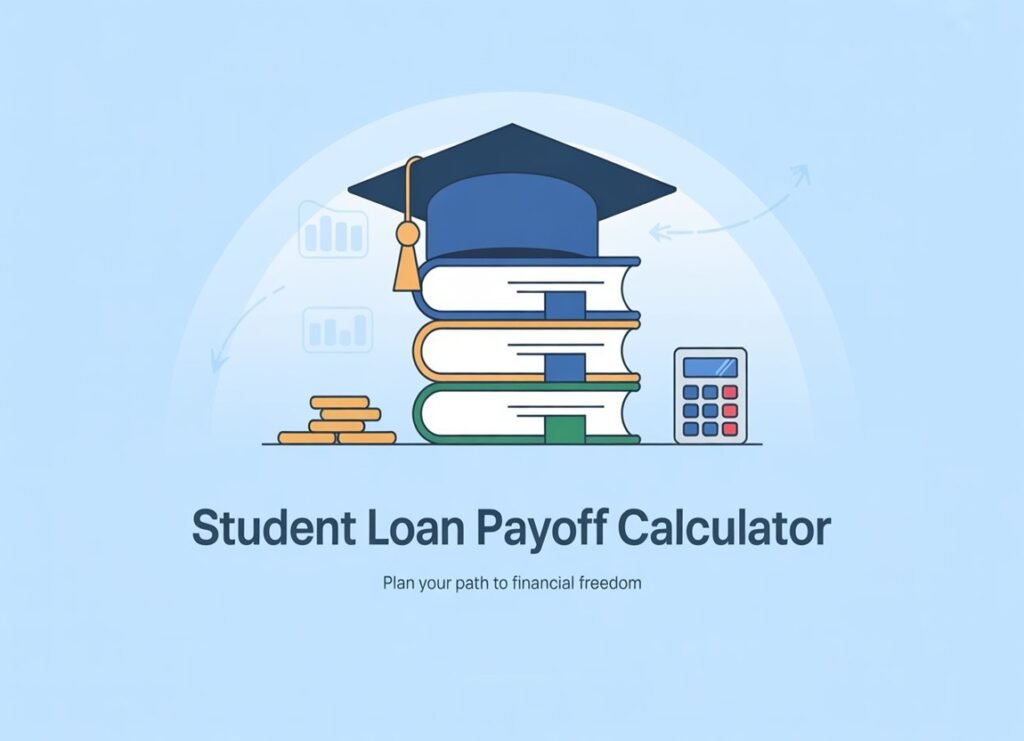Income Driven Repayment Calculator
Calculate your monthly payments and loan forgiveness options
Loan Information
Repayment Plan
Repayment Results
Your estimated monthly payment
under REPAYE plan
Disclaimer: This calculator provides estimates only. Actual payments may vary based on your specific loan terms, income verification, and other factors. Consult with your loan servicer for precise payment amounts.
Introduction: Why Income Driven Repayment Calculator still matter
If you are burdened by federal student loans, it can be overwhelming to determine how much to pay each month. Income Driven Repayment plans are designed to be affordable, as they set your monthly payment according to your income, family size, and other relevant criteria. As news like the SAVE plan hits in 2025, having an Income Driven Repayment Calculator becomes more important than ever.
In this guide, you’re going to learn what an Income Driven Repayment Calculator is and why you need it so that you can save money, wash away the fear of surprises later on, and even plan for forgiveness programs like PSLF (Public Service Loan Forgiveness). Whether you are a recent graduate, in the workforce, or a financial planner advising clients, this resource will provide clarity and confidence.
What Is an Income Driven Repayment Calculator?
Income Driven Repayment Calculator: An Income Driven Repayment Calculator is a website-based tool that helps you determine your monthly student loan payment under any of the federal IDR plans. Rather than imposing a standard 10-year repayment term, these plans set your monthly payment based on your income and family size to ensure the costs remain affordable.
You input information such as your loan balance, interest rate, income, family size, and state. The calculator then displays your estimated monthly payment, projected total repayment, and potential forgiveness amount.
Why Finance Professionals and Borrowers Rely on It
Income Driven Repayment Calculator are used by financial advisors and loan applicants to determine budgeting, the long-term value of the loan, and to compare different repayment options. A good calculator will also incorporate the latest federal guidelines, allowing you to make an informed choice about switching plans or recertifying your income.
How Our Income Driven Repayment Calculator Works
You Will Need to Input The Following Keys
In order to produce a precise result, these are what you’ll generally need:
- Loan principal: the total you owe.
- Rate of interest: influencing the overall price
- AGI: the amount of used to determine payments
- Number of family members: includes spouse and dependents.
- State you live in: changes how the poverty guidelines are figured
Step-by-Step Walkthrough
- Add in your loan information (balance, interest rate).
- Enter your income and family size.
- Select your filing status (single, married filing jointly/separately).
- Choose one of the IDR plans you’d like to review or have the calculator compare all of them.
- Review the findings, which will provide you with your monthly payment and outline what you can expect to repay in full.
Example Calculation
Say you have $50,000 in federal student loans at a 5 percent interest rate and earn $50,000 a year. There is one family member in the calculator, which results in a round figure of $170 per month under the SAVE plan. This is much less than the typical 10-year plan payment of around $530.
Types of Income Driven Repayment Plans Covered
SAVE Plan (2025 Updates)
The newest and most generous IDR plan is the SAVE plan (Saving on a Valuable Education). It caps monthly payments at 10 percent of discretionary income, and provides interest subsidies that keep your balance from growing if you are making payments.
PAYE (Pay As You Earn)
PAYE caps payments at 10 percent of discretionary income and forgives the balance after 20 years. Good For Borrowers with high debt-to-income ratios.
REPAYE
Like PAYE, but there is not an income limit. REPAYE comes with an interest subsidy and the possibility of forgiveness after 20 or 25 years.
IBR (Income-Based Repayment)
IBR limits payments to 10–15% of discretionary income, depending on when the loan was borrowed, with forgiveness after anywhere from 20–25 years.
ICR (Income-Contingent Repayment)
ICR payments are the lesser of 20% of discretionary income or a fixed plan over 12 years adjusted for income and frequently used by Parent PLUS borrowers who consolidate.
Benefits of Using an Income Driven Repayment Calculator
See and Manage Your Money Clearly
You will know exactly how much you will owe each month, and how much interest will accumulate over time.
Prevents Overpayment
Rather than overpaying an amount that exceeds what is necessary for a standard plan, IDR ensures payments are proportionate to income.
Helps You Plan for Forgiveness
If you would qualify for PSLF or long-term forgiveness after 20 to 25 years, the calculator displays how much debt could be forgiven.
Avoids Surprises with Interest Accrual
Some calculators display how much interest will be subsidized with SAVE, to prevent your balance from ballooning.
When to Use an Income Driven Repayment Calculator
- Before consolidating loans: help you pick the best plan.
- At annual income recertification: understand how your new payment will be different.
- In response to major life events: marriage, job transition, or new family member.
- If you are planning to pay off early versus forgiveness these total costs may make a difference.
Common Mistakes to Avoid with Income-Driven Repayment
- Failure to meet recertification deadlines for income: can lead to payments that spike.
- Not taking into account interest capitalization: can inflate your total repayment.
- Choosing the wrong plan: all plans are not created equal.
- Disregarding the effect of marital status: it’s possible for filing jointly to increase your payments under some plans.
Advanced Tips for Maximizing IDR Savings
- Tax Filing Position: There may be a desire to file separately in an attempt to reduce AGI (if advantageous).
- Employer Help: Combine IDR with student loan repayment contribution from the employer.
- Windfall Payments: Apply bonuses or tax refunds to the principal.
- Refinancing Plan: Do not refinance until you’re certain forgiveness is off the table.
Why our Income Driven Repayment Calculator Is the Best
In the Moment Accuracy with Updated Federal Recommendations
The SAVE plan, poverty guidelines, and interest subsidies are all changes we regularly implement in our tool.
Beginner-Friendly Design + Pro-Level Insights
Our calculator is simple enough for new graduates and comprehensive enough for financial planners.
Mobile-Friendly, Fast, and Free
You can use it on any device without downloading anything.
Privacy-First (No Data Sharing)
Your personal information is never saved or shared.
Related Tools & Resources
Conclusion – Income Driven Repayment Calculator
What is Income Driven Repayment? By utilizing quality Income Driven Repayment Calculators you will be able to make comparisons, avoid errors that could end up being expensive and plan for forgiveness programs.
Spend a few minutes entering your numbers today to see how much you could potentially save each month. The right strategy can free up money for the future while keeping your debt in check.
Checkout our Finance related tools at: All Tools Co
Also visit health related tools at: Healthy Vibes24
FAQ: Income Driven Repayment Calculator
1. What is the best income-driven repayment plan in 2025?
The SAVE plan has the lowest payments and provides interest relief for most borrowers. However, the best plan depends on your income, family size, and career plans.
2. How accurate is an income driven repayment calculator?
At the end of the day, it is very accurate, provided you enter accurate data. It uses the exact same formulas as the Department of Education.
3. Can I switch IDR plans anytime?
Yes, you can change plans, but you might have to consolidate loans first if you hope to participate in certain ones.
4. Will IDR plans cover my private loans?
No, IDR plans are only available for federal student loans.
5. Does IDR affect my credit score?
Remaining up to date on payments under IDR helps maintain the best possible record of a positive payment history for credit.
6. What happens after 20 or 25 years of payments?
Any unpaid balance is also forgiven, though you may owe taxes on it (except for PSLF, which is tax-free).
7. How does the SAVE plan change my payments in 2025?
SAVE reduces your cap on monthly payments and provides an interest subsidy to curb balance growth.
8. Is it better to pay off student loans early or stay on IDR?
It depends on your goals. If you anticipate trying to qualify for forgiveness, reduced payments could save you cash. If not, early payoff means less interest.
9. How does marriage affect income-driven repayment?
If you file taxes together, your spouse’s income could be considered when determining your payment.
10. Can I still qualify for PSLF while on IDR?
Yes, PSLF mandates you to be on an eligible repayment plan, of which most IDR plans are.


Pingback: Loan comparison calculator | Best Tool 2025